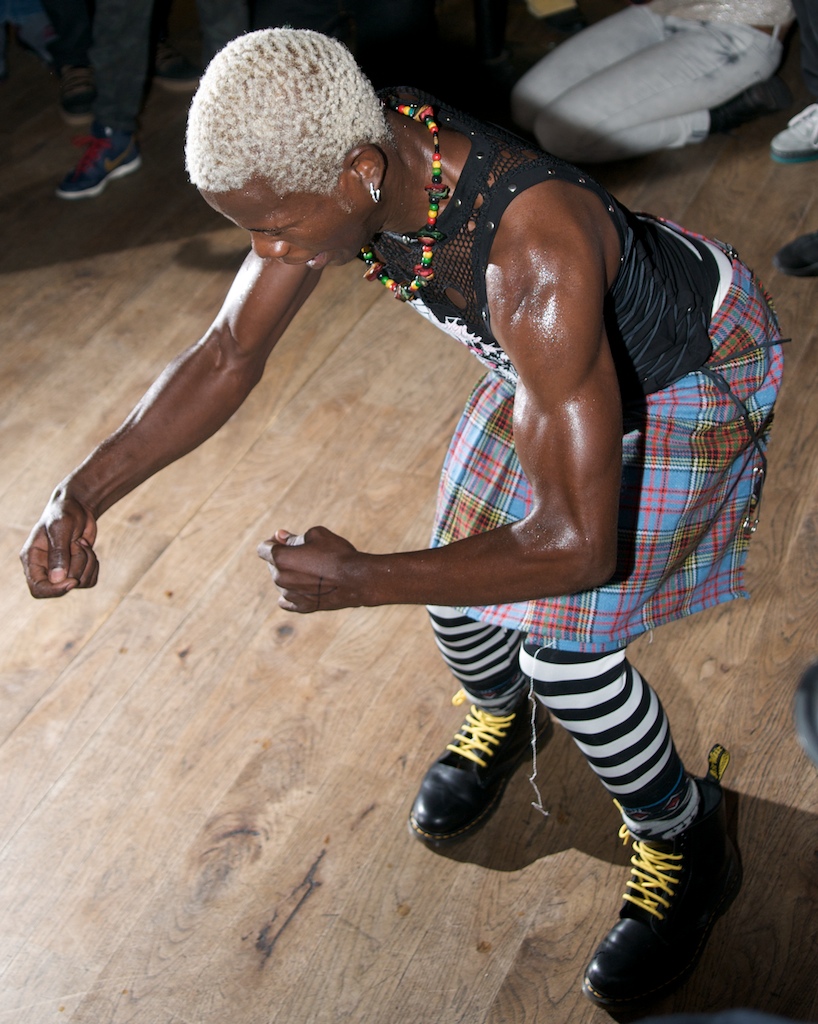Blog January 2, 2013
Os Kuduristas- Live in NYC
Given our long standing interest in Angolan musical (check out our HIP DEEP ANGOLA shows for more evidence!), we have eagerly followed the progress of Os Kuduristas ever since the traveling dance/performance/fashion show was first announced. So, when after a number of European appearances, the crew finally made it to the US, we got a chance to check them out in person, and ask them exactly what their whole project was about.
Os Kuduristas only made a few public appearances in New York (as well as several more informal sessions with musicians and students), and the first was at Bembe, a small club in Williamsburg with an adventurous booking policy. After an opening set by DJ Chief Boima (who has his own thoughts about the projects), the dancers worked their way through the packed crowd from the back of the club, opening up a circle in the middle of the audience. The performance was remarkable. While it's easy to find countless videos of Kuduro dancers online (or even on the website for Os Kuduristas), little- if any- footage does justice to the specificity of the style's energy. In YouTube videos, it tends to look quite a bit like break-dancing. Live, it quickly becomes apparent that while some of the movements may be the same, the logic governing them is fundamentally different. Kuduristas play with their movements, mocking, copying, elaborating- the active engagement and incorporation of ideas drawn from around the world is a key to the cosmopolitan style.
When we talked with Manuel Kanza, who did much of the choreography for the group, he spoke about this further. "The modern style of Kuduro is things that are happening now. For example if we see a folk dancer we will imitate his movements and make fun of it, but not make fun of it to irritate somebody, but to make it into a Kuduro flavor." Of course this culturally omnivorous approach to influence isn't just confined folk styles. While the dance's basic forms emerge from long-standing Angolan traditions, moves get pulled from everywhere, from voguing to hip-hop to Madonna. The competitive search for the new has lead Luanda's dancers through a rapid stylistic evolution, and the sense of challenge between the performers of Os Kuduristas-even after months of sharing the same stage- was still palpable, as each pushed the others to go further.
The next night (after leaving Bembe with the crowd still visibly wanting more), the Os Kuduristas crew got a chance to mix it up at break dance party crew at Le Poisson Rouge, in downtown Manhattan. When they arrived at about 1 in the morning, a lively dance circle was already in full swing. Guys took turns jumping into the middle, showing off their pops and spins. The DJ blasted house music as a trombone player jammed along. The OK crew made their way directly to the center of the floor, watching attentively as their American compadres did their thing. You could see the OK guys moving in place, trying out some of the moves they were seeing. Then, finally, it was their turn. A cheer went up as they entered the circle and the DJ announced, "Os Kuduristas from Angola! Kuduro!" Each of the five OK dancers had distinctive moves, including one who mimed being hung up on a hanger and another who did flips and landed on his back on the wood floor. The sole woman in OK was a big hit with her playful, sensuous moves. She drew out some American guys to join the fun. Perhaps the most interesting part of the evening was the opportunity it granted to compare the Americans and the Angolans side by side. One noticeable difference was intense physicality of the Americans, who moves (particularly those on the floor) seemed to demand intense strength. By contrast, the Angolans were far more theatrical, using their moves to tell stories, engage in conversation. Mixed with their colorful costumes and hair styles, the impact of their style was immediately impressive. While we wish that there had been more of a live music component to the performance, Os Kuduristas was a truly minding bending time, one that we can only hope is repeated soon.
Check back here soon for the full transcription of our interview with Manuel Kanza, the group's primary choreographer.
Meanwhile- Check out some more photos!















